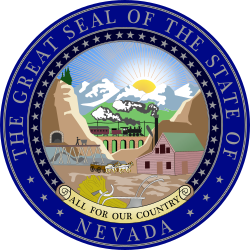November 8, 1904 | |||||||||||||||||||||||||||||||||
| |||||||||||||||||||||||||||||||||
 County Results Roosevelt 40–50% 50–60% 60–70% | |||||||||||||||||||||||||||||||||
| |||||||||||||||||||||||||||||||||
| Elections in Nevada |
|---|
 |
The 1904 United States presidential election in Nevada took place on November 8, 1904, as part of the 1904 United States presidential election. Voters chose three representatives, or electors to the Electoral College, who voted for president and vice president.
Contents
Nevada was won by the Republican ticket of incumbent President Theodore Roosevelt of New York and his running mate Senator Charles W. Fairbanks of Indiana. They defeated the Democratic nominees, former Chief Judge of New York Court of Appeals Alton B. Parker and his running mate, former US Senator Henry G. Davis of West Virginia.
Roosevelt and Fairbanks would win the state by a margin of 23.79%, [1] roughly mirroring the results of the national popular vote. After the state had voted overwhelmingly for James B. Weaver and William Jennings Bryan during the three previous elections, Roosevelt claimed the state for the Republican Party for the only time between 1888 and 1920.
Roosevelt won every county in the state, becoming the first Republican presidential candidate to do so; this has since only been repeated by Richard Nixon in 1972, Ronald Reagan in 1980 and 1984, and George H.W. Bush in 1988. This election was the first time since its establishment in 1866 that Lincoln County backed a Republican candidate. Additionally, Humboldt County voted for a Republican for the first time since 1872.
Following this election, Nevada would eventually become a bellwether that has reflected the result in 26 of the 29 presidential elections since (the exceptions were in 1908, 1976 and 2016).



